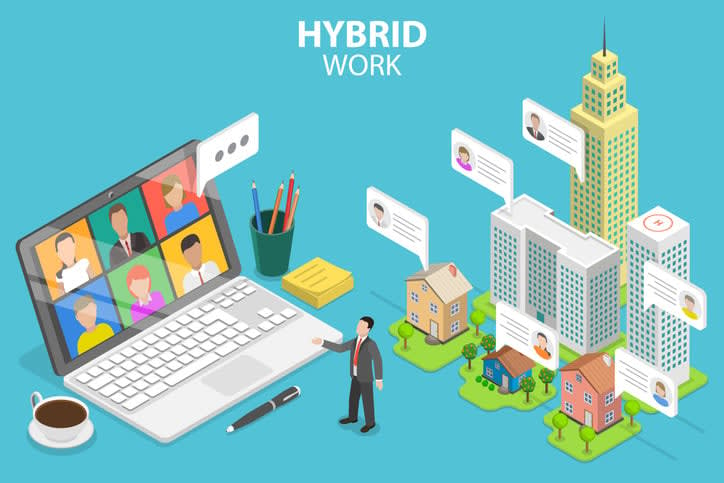Hybrid remote work is a flexible model that merges office and home or elsewhere working, allowing employees to alternate. This flexibility lets employees enjoy the benefits of both environments. In this article, we will define hybrid remote work, explore different models, discuss its benefits and challenges, and provide tips for successful implementation, all while understanding the hybrid remote meaning.
Key Takeaways
- Hybrid remote work models combine in-office presence with the flexibility of remote work, promoting work-life balance and improving productivity.
- Different types of hybrid remote models include flexible hybrid, split-week, and week-by-week, which cater to diverse employee needs and operational requirements.
- Successfully implementing hybrid remote work requires thoughtful planning, leveraging technology, and designing flexible office spaces. It also requires addressing challenges related to communication, coordination, and inclusivity.
Defining hybrid remote work

Hybrid remote work, often simply referred to as hybrid work, is a transformative approach that combines the structure of in-office presence with the freedom of remote work. Hybrid remote working is a balanced equation, offering employees the best of both worlds: the ability to work remotely, minimizing daily commutes, and providing the comfort of home or any chosen environment alongside scheduled in-office days for collaboration and social interaction, all aimed at delivering maximum productivity.
The heart of a hybrid remote work schedule beats with flexibility, allowing employees to seamlessly toggle between their desks at the office and their chosen remote setting. This isn’t just about working from different locations; it’s about creating a rhythm that supports:
- focused, independent work
- fostering face-to-face connections
- fostering teamwork
- fostering company culture
But why has hybrid work surged in popularity? The answer lies in the shifting sands of employee expectations and the pursuit of an enhanced work-life balance. The hybrid work model is lauded for its ability to improve productivity and offer a reprieve from the constraints of a fully remote or in-office setup, making it an increasingly preferred choice for forward-thinking organizations.
Types of hybrid remote models

Diversity is key in the realm of hybrid remote work, and there’s no one-size-fits-all model. Companies may opt for an office-first approach, where employees spend the bulk of their time in the office, punctuated by the option to work remotely on certain days. Conversely, the remote-first model flips the script, making remote work the default while keeping office space for occasional use.
For those craving more autonomy, there are several flexible work models to consider:
- The flexible hybrid model: This model allows employees to choose their in-office and remote days based on personal preference and workload.
- The split-week model: This model designates specific days of the week for on-site work and the remaining days for remote work.
- The week-by-week model: This model alternates between on-site and remote work on a weekly basis, providing a predictable yet dynamic schedule.
These models offer employees the freedom to balance their work and personal lives while still meeting their job responsibilities. However, out of the office, people can feel out-of-place, so a virtual office like Kumospace’s platform creates a replica or a way-out alternate reality that makes it a fun place to work and keep tabs of other remote colleagues and have meetings without waiting for endless Zoom or Slack confirmations.
These hybrid models are a testament to the workplace's adaptability, accommodating various operational needs and employee lifestyles. Whether embracing a fully remote culture or blending remote work with in-person collaboration, the spectrum of hybrid remote models is broad and ever-evolving.
Benefits of hybrid remote work

The adoption of hybrid remote work brings a bouquet of benefits, including:
- A better work-life balance
- Reduced daily commute, allowing employees to reclaim time for family, hobbies, or unwinding
- Decreased stress levels
- Improved job satisfaction
But the perks extend beyond personal convenience. Hybrid work models unlock a higher degree of productivity by allowing individuals to work at times when they feel most creative and focused. Companies also reap financial rewards, trimming down on real estate costs due to a reduced need for expansive office spaces, while simultaneously tapping into a larger talent pool not restricted by geographic boundaries.
This model is particularly beneficial to vulnerable groups such as parents, caregivers, and those with disabilities, offering them an inclusive work environment tailored to their needs. By fostering a culture that values flexibility, organizations not only enhance their employees’ quality of life but also position themselves as attractive employers in a competitive job market.
Challenges of hybrid remote work

Despite its advantages, hybrid remote work is not without its hurdles. The intricacies of managing hybrid remote teams can give rise to issues in communication, coordination, and culture. Remote team members may feel out of the loop during impromptu office discussions, potentially leading to a sense of isolation and inequality.
Ensuring that remote workers have equal access to information and opportunities is crucial, as overlooking them for advancements or failing to integrate them into the company culture can lead to disengagement and turnover. Moreover, the blend of in-person and remote work demands meticulous documentation and inclusive practices to maintain a cohesive team dynamic.
As companies navigate these challenges, they must also contend with the emotional aspects of change. Some employees might feel trepidation as they adjust to new work arrangements, making it imperative for organizations to support them, and maintain team building, through this transition. Addressing these challenges head-on is essential for building a sustainable and effective hybrid work environment.
Implementing a hybrid remote model

Embarking on the hybrid remote work journey is an exciting venture that requires thoughtful planning and strategy. It’s about more than just deciding who works where and when; it involves:
- Crafting a clear hybrid work policy
- Choosing the right hybrid schedule
- Optimizing office spaces
- Implementing technology solutions that support diverse work styles
Addressing legal and compliance challenges, especially when building a distributed workforce, is also critical to ensure a smooth transition for all parties involved.
Choosing the Right Hybrid Schedule
Selecting the ideal hybrid schedule is akin to tailoring a bespoke suit—it must fit the company's and its employees' unique contours. Flexibility is paramount, and rigid rules around in-office days should be avoided unless they directly contribute to the organization’s objectives. The outdated notion of the 9-to-5 workday is giving way to more dynamic and individualized work schedules.
Companies like Amazon and Disney have set hybrid work policies, requiring employees to be in the office a minimum number of days to foster collaboration and maintain the essence of the workplace culture. Other firms, like JPMorgan, implement these policies to preserve operational integrity and ensure that senior staff are accessible for mentorship and decision-making. In all cases, the chosen hybrid schedule (and software to manage it) should reflect the company’s goals while also accommodating employee needs and preferences.
Zoom’s approach exemplifies a balance between flexibility and structure, with employees living within a certain radius of an office expected to come in for a portion of the week. This mix of set and flexible work schedules empowers team members to customize their work experience, tailoring it to when and how they work best, ultimately contributing to both individual and organizational success.
Designing hybrid-friendly office spaces
The physical layout of an office can significantly impact the success of a hybrid remote work model. Designing spaces that cater to:
- Socialization
- Focused work
- Meetings
- Employee well-being
is essential. For example, Microsoft has introduced ‘touchdown’ spaces, allowing employees who work in-house occasionally to do so without a permanent office, thereby promoting flexibility.
In Japan, Fujitsu has embraced the concept of a ‘borderless office,’ creating an ecosystem of spaces that supports the diverse needs of its team. Such environments facilitate not only the day-to-day tasks of in-office workers but also provide welcoming spaces for remote employees when they choose to work onsite, ensuring everyone feels equally valued and supported.
The aim is to move away from the traditional office setting, crafting an office environment that is both functional and adaptive to the varying requirements of a hybrid workforce. This includes incorporating elements like quiet zones for focused tasks, open plan areas for collaboration, and private conference rooms for confidential discussions or virtual meetings, all contributing to a more sustainable future for the workplace.
Leveraging technology for hybrid work
The backbone of any successful hybrid remote work model is the technology that enables it. Utilizing platforms like Slack for seamless communication and Zoom for meetings ensures that both remote participants and in-office counterparts are equally engaged. These tools bridge the distance between team members, fostering a sense of connection and collaboration regardless of location. However, they are much-loathed among many workers for the lack of personality, so consider Kumospace as a great way to keep a team focused through ad hoc and planned meetings.
Zoom, for instance, offers in-office video call solutions that recognize individual faces in a shared room and pull them into separate panes for remote colleagues. This level of innovation is key to facilitating a hybrid remote work environment where every employee, whether dialing in from home or participating in person, feels included and visible.
In addition to communication tools, project management software and virtual community spaces are critical in maintaining project momentum and building team rapport. Companies are also turning to specialized platforms like OfficeRnD Hybrid to create collaborative workspaces that cater to the needs of a distributed workforce. Embracing these technologies is essential for cultivating a dynamic and efficient hybrid workplace.
Supporting hybrid remote teams

The success of hybrid remote teams hinges on effective support systems that encourage communication, trust, and collaboration. Here are some strategies to consider:
- Replace casual in-person chats with structured virtual coffee dates
- Use apps for team communication to keep team members connected
- To make meetings more collaborative and inclusive, share meeting agendas in advance and invite contributions from all team members, whether remote or in the office.
Building a virtual community for non-work related discussions is another tactic to bridge the gap between remote and in-house employees, fostering a sense of belonging and mitigating feelings of isolation. Prioritizing employee well-being, providing flexible workspace options, and actively encouraging feedback are all strategies that enhance the hybrid work culture.
It’s also crucial to address the physiological stress that some team members may experience in a hybrid-remote setup. By creating equal benefits for remote and in-house employees, organizations can prevent feelings of inequality and ensure all employees feel valued, regardless of their physical location. Scheduling team-building events that include both in-person and remote participants is fundamental to maintaining a unified, engaged, and satisfied team.
Businesses must also ensure that continuity and contingency plans are updated to cater to remote and hybrid workers. Taking into account their local risks and additional benefits they can bring to a business.
Case studies of successful hybrid remote companies

Some companies stand out as shining examples of successful hybrid remote work implementation. Microsoft, for instance, has embraced the flexibility of remote work by allowing employees to work from home permanently, albeit with adjustments to pay based on location if they choose to move away from the office. This approach ensures that employees have the autonomy to choose their work environment while maintaining a connection to the company’s ecosystem.
CRM vendor HubSpot takes a different tack by offering employees the choice to be fully remote, engage in hybrid work, or work full-time in the office. This level of choice has led to increased employee engagement, as team members have the freedom to select the work arrangement that best suits their individual needs and preferences.
These case studies highlight the importance of offering a range of work arrangements to meet diverse employee needs. By doing so, companies like Microsoft and HubSpot not only boost employee satisfaction but also position themselves as flexible and adaptive employers in today’s dynamic job market.
Summary
As we’ve journeyed through the intricacies of hybrid remote work, it has become clear that this model offers a compelling blend of flexibility, productivity, and inclusivity. While challenges do exist, they are not insurmountable, and the benefits of a well-implemented hybrid model are manifold. Companies looking to thrive in the modern workforce should embrace the hybrid model to attract top talent, foster employee well-being, and build a resilient, adaptable organization. Let this be your call to action to explore the possibilities and pave the way for a more balanced and fulfilling work future.
Frequently Asked Questions
A hybrid remote work model allows employees to split their time between working in a physical office and working remotely, offering a balance between focused independent work and in-person collaboration. This model provides flexibility for employees to work both in the office and remotely, promoting a balance of individual productivity and team interaction.
A hybrid remote work schedule benefits employees by offering better work-life balance, reducing stress from commuting, providing autonomy over working hours, and allowing them to work in a productive environment (answer 1, paraphrased).
Yes, hybrid remote work can present challenges in maintaining consistent communication and a cohesive company culture, but these challenges can be mitigated through the use of technology, clear policies, and inclusive practices. Using Kumospace helps bring the best of both worlds together with a fun virtual office environment to keep employees happy.
Yes, there are different types of hybrid remote work models, such as office-first, remote-first, flexible hybrid, split-week, and week-by-week models, each with varying levels of flexibility and in-office requirements.
To support hybrid remote teams effectively, companies should focus on clear communication, trust, collaboration, employee well-being, and inclusive team-building events. These efforts can foster a cohesive and productive work environment.





